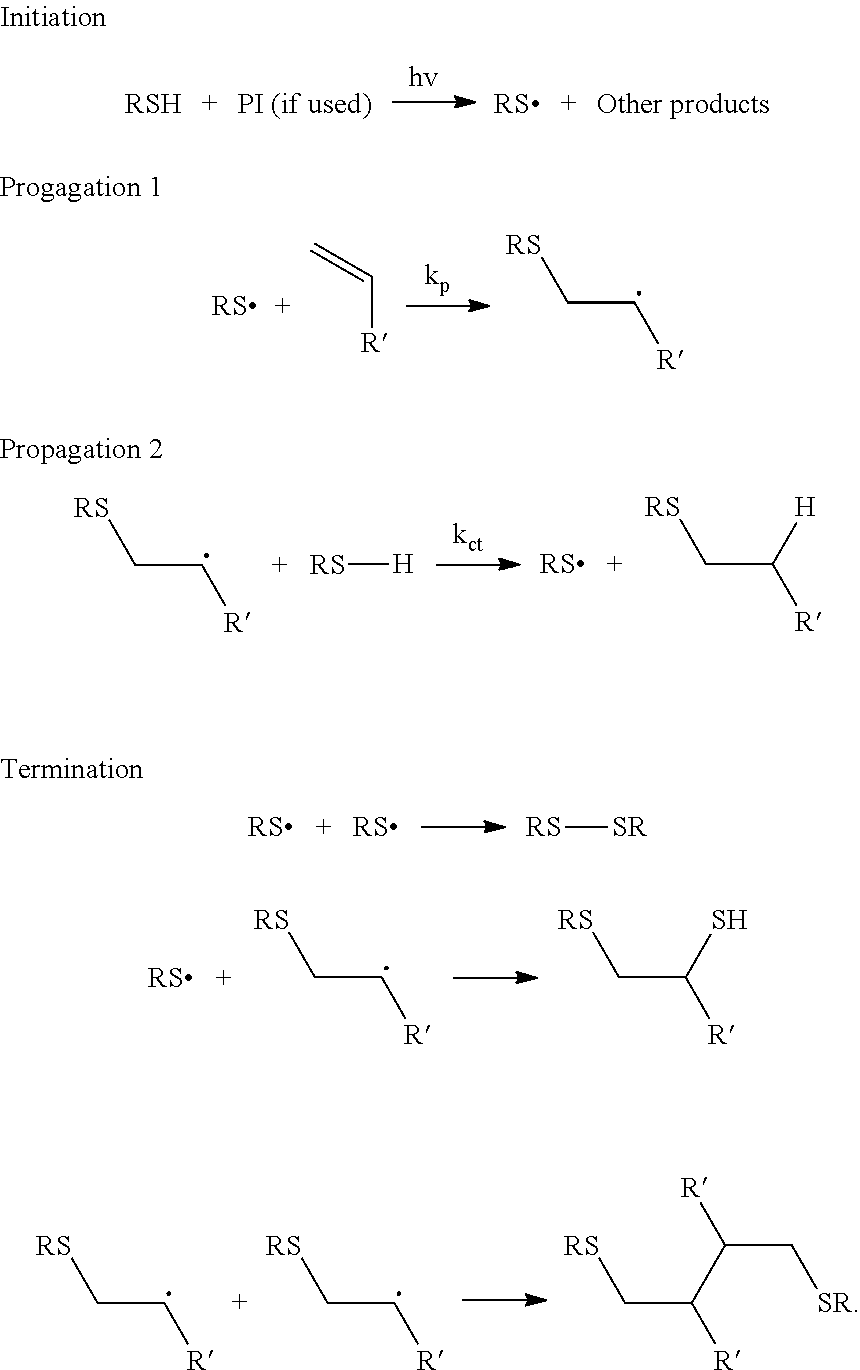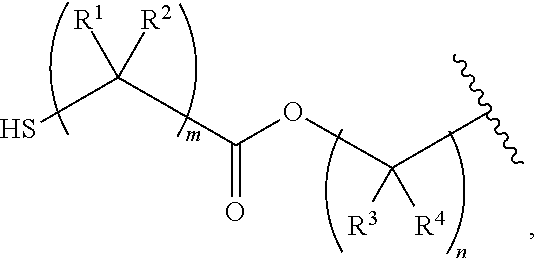Nail polish
a nail polish and coating technology, applied in the field of nail polish, can solve the problems of excessive weight in the transportation of products, waste of nail coating composition proportion, and inability to meet the needs of application, and achieve the effect of high gloss finish
- Summary
- Abstract
- Description
- Claims
- Application Information
AI Technical Summary
Benefits of technology
Problems solved by technology
Method used
Image
Examples
example 1
[0327]
IngredientsDescriptionAmountGenomer 2280 - RahnModified bisphenol A43.3epoxy diacrylateFor radically curableinks, coatings andadhesivesData Sheet dated29 Aug. 2006version 1.002 / HSFunctionality: 2;Colour index: ≦6GardnerViscosity:5000 cPs / 25 C.;Density: 1.20Butane-1,4-diol diacrylate12.02-ethyl-2-18.1((methacryloyloxy)methyl)propane-1,3-diyl bis(2-methylacrylate)Pentaerythritol tetrakis (3-12.0mercaptopropionate)EDTA (Na Salt)0.1Triphenyl-phosphite (TPhPh)0.4(1-6.0hydroxycyclohexyl)(phenyl)methanone(Irgacure 184)2,2 Dimethoxy 1,2 diphenylethan-1-1.2one (Irgracure 651)Organic Red D&C Ca Lake CI Number6.015850 - 5% (COD 8001)Inorganic White Titanium Dioxide CI0.877891 - 0.7% (COD 8008)100
example 2
[0328]
IngredientDescriptionAmountGenomer 2280 - RahnModified bisphenol A epoxy diacrylate24.9For radically curable inks, coatings andadhesivesData Sheet dated 29 Aug. 2006version 1.002 / HSFunctionality: 2; Colour index: ≦6GardnerViscosity: 5000 cPs / 25 C.; Density: 1.20Genomer 03-956 - RahnAliphatic urethane Dimethacrylate14.9Monomer free for radically curable inks,coatings and adhesives.Data Sheet dated 7 May 2009, version1.001 / RWColour Index: ≧3 Gardener; Viscosity:8700 cPs / 25° C.; Tg: 43° C.; Density:1.11; Functionality: 2Butane-1,4-diol diacrylate9.02-ethyl-2-16.9((methacryloyloxy)methyl)propane-1,3-diyl bis(2-methylacrylate)Acrylic Acid2.0Pentaerythritol tetrakis (3-19.9mercaptopropionate)Tetrasodium EDTA0.05Triphenyl-phosphite0.3Capstone FS-3100Partially fluorinated alcohol substituted0.2glycol(1-5.0hydroxycyclohexyl)(phenyl)methanone(Irgacure 184)2,2 Dimethoxy 1,2 diphenylethan-1-1.0one (Irgracure 651)Bis(2,4,6-trimethylbenzoyl)-0.5phenylphosphineoxide (Irgacure 819)Organic Red...
example 3
[0329]
IngredientDescriptionAmountEbecryl 270 - CytecAliphatic Urethane27.3Acrylate RadcureTechnical PublicationPub No 210115Eversion CViscosity:135000 cPs / 25 C.Density: 1.1Functionality: 2Mwt: 1500Butane-1,4-diol diacrylate13.7Bisphenol-A-Dimethacyrlate13.7Nitro cellulose2.2Acrylic Acid2.72-ethyl-2-15.5((methacryloyloxy)methyl)propane-1,3-diyl bis(2-methylacrylate)Pentaerythritol tetrakis (3-10.9mercaptopropionate)Tetrasodium EDTA0.03(1-5.5hydroxycyclohexyl)(phenyl)methanone(Irgacure 184)Benzophenone2.7Bis(2,4,6-trimethylbenzoyl)-0.5phenylphosphineoxide (Irgacure 819)Organic Red D&C Ca Lake CI4.8Number 15850 - 5% (COD 8001)Inorganic White Titanium Dioxide CI0.777891 - 0.7% (COD 8008)100.0
PUM
| Property | Measurement | Unit |
|---|---|---|
| wavelength radiation | aaaaa | aaaaa |
| wavelength | aaaaa | aaaaa |
| volume | aaaaa | aaaaa |
Abstract
Description
Claims
Application Information
 Login to View More
Login to View More - R&D
- Intellectual Property
- Life Sciences
- Materials
- Tech Scout
- Unparalleled Data Quality
- Higher Quality Content
- 60% Fewer Hallucinations
Browse by: Latest US Patents, China's latest patents, Technical Efficacy Thesaurus, Application Domain, Technology Topic, Popular Technical Reports.
© 2025 PatSnap. All rights reserved.Legal|Privacy policy|Modern Slavery Act Transparency Statement|Sitemap|About US| Contact US: help@patsnap.com



